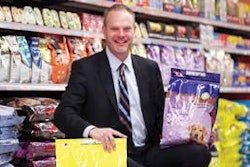
Premium petfoods—defined by Packaged Facts as those priced at least 10% above the category average—accounted for 40% of petfood sales in 2010, followed by regular petfood at 27% and value petfood at 14%, with treats comprising the remaining 18% of sales. On both the dog and cat sides of the market, the premium share of sales has contracted a bit with the recession while the regular and value segments have risen a notch or two. Although the premiumization trend is still in strong force, many of the mass shoppers to be converted to premium foods have already entered those ranks, so the challenge now will be to continue to attract consumers to even higher priced foods in the superpremium classification, which remains centered in the pet specialty and veterinary channels.
Let's be clear: The terms premium and superpremium are ambiguous and have no formal definition in the petfood industry. The terms are often used interchangeably to describe both top-of-the-line specialty foods and above-average mass-market foods in value-added formulations or presentations, such as gourmet, natural, high nutrition, better tasting and human grade. According to Packaged Facts, the term superpremium is generally reserved for the highest quality products, which are positioned on clear-cut health claims (and higher prices), thereby ruling out most mass-market brands and concentrating in the pet specialty channel. These gourmet petfoods are distinguished by appetizing names and attractive packaging/label graphics designed to appeal to human sensibilities. The products are also characterized by human-style ingredients, textures, sauces and cuts, and often by single-serve containers.
Partly because of its stronger emphasis on niche products and animals other than dogs and cats, the pet specialty channel is much more fragmented than the mass-market channel—says the Packaged Facts report, Pet Food in the US, 9th Edition—with dozens of dog and cat food marketers fielding premium products, including those positioning on natural/organic/holistic and premium/gourmet appeals. Although the rapid sales growth of natural and organic products slacked off during the recession due to the products’ premium price tags, high interest in “natural” remains in full force on the manufacturing side. Removing any doubt that the recession has had a dampening effect on the premium side of the market, the package tag “upscale” dove from 168 mentions in 2009 to 88 in 2010. Nonetheless, most of the products coming to market clearly are still upscale if the prevalence of the term “natural” is any indication.
Packaged Facts estimates that US retail sales of petfood totaled US$18.4 billion in 2010, up 2.8% over 2009 sales. During the five-year period from 2006 to 2010, the market grew by a total of 21% and posted a compound annual growth rate (CAGR) of 4.8%. Although petfood sales continued to perform reasonably well during the recession, growing 5% annually in 2008 and 2009, the lingering economic slump drove the growth rate below 3% in 2010, the slowest going the market has seen since the turn of the millennium, according to Packaged Facts data.
The good news? As the economy improves, so should all things pet—but that recovery continues to appear very gradual. Sales of petfood will not return to their pre-recession 5%-6% rates of annual growth during the 2010-2015 period, although Packaged Facts does predict gradual improvement over the 2.8% rate of growth charted in 2010.
The “pet parent” sentiment arguably has never been stronger; during the uncertain economic times of the past couple years, many pet owners have found themselves valuing the comfort and security their pets offer more than ever. Accordingly, when it comes to new product development and marketing, a trend dubbed by Packaged Facts as “functional pampering” is essential. "If a product pleases and pampers a pet, that’s great, but if it also meets a functional need, that’s even better, and products like omega-3-infused treats hit the functional pampering nail on the head," concludes the report.

















